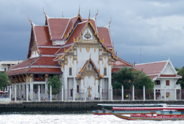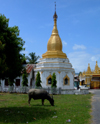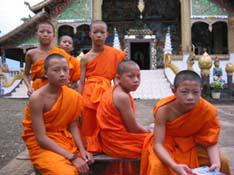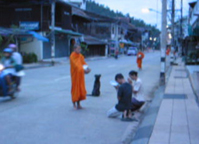Elements of Buddhism
Temple
The temple is the core of Shan religion. Much of Shan religion and community revolves around the temple. Many people visit the temple daily to make merit, receive teaching, and get their fortunes told. Those who are more serious about seeking the benefits of Buddhism enter the temple life. There are three types of temples used by the Shan people:
1. Thai style, which is characterized by horns sticking off every corner of the roof, called the “cho fa.”
2. Burmese style, which has a conical appearance.
3. Lanna style, which is characterized by a tiered roof structure and silver filigree lining the base of each roof tier. This style is used specifically for Shan temples.
 (Thai) |
 (Burmese) |
 (Lanna) |
Monks
Traditionally, monks are guardians and purveyors of Buddhist teaching and Shan culture, performing services ranging from exorcisms of evil spirits to funerals. Today, monks are also consulted for their purported abilities to read the stars. Information ranging from a profile of a thief to winning lottery numbers can be sought from a monk who is believed to have astrological fortunes at his fingertips. This is just one of many practices monks perform day to day which provide evidence that even Shan monks have incorporated animistic and occult beliefs into Buddhist teaching and practices.
Many Shan parents give their sons to be monks at a very early age and then again at the age of twenty. This is described as the practice of repayment. “You become a monk when you are small to thank your mother for giving you the milk from one of her breasts and then when you are 20 you become a monk for 7 days to thank your mother for the milk from the other breast.” This teaching of repayment is ingrained in Shan culture.
 (Khemacari) |
 (Thai Monks in Training) |
Apart from repayment, men become monks at all different ages for many different reason. Some become monks because their lives are empty and they want to do something they see as significant. Some boys become monks because their parents have died and they have no where to go. Some become monks for basic provision and many become monks because they do not want to work. Some men become monks out of curiosity. Since one can become a monk for as little as 7 days to a month, this seems pretty easy to do.
Once in the priesthood one becomes an integral part of the societal framework in the Shan village. Their main responsibility is to teach people about Buddhism. They can also be hired to help people ward off evil spirits. One cannot enter the priesthood until the age of 20. They are not to be touched by women. They can be noticed mainly by their bright saffron robes and have to follow 227 laws. In Shan society, the monk is revered and respected.
There are different levels within the monkhood. After entering the priesthood at the age of 20, a higher position can be attained called the prasawati, or an abbot. Additionally, there are the positions of pratsawami and prakrubha. The highest position that is currently filled by Khemacari, the most venerable monk in the Shan state, is called somdet achayatam, or “Master of Dharma.” Although there is a higher position beyond this, it is currently unoccupied because a monk must reach the age of 80 in order to qualify for that position.
Merit
In order to atone for wrongs done, a person must participate in merit-building activities . These merit building activities can be suffering penance for evil deeds or doing good deeds such as giving alms to monks. Although giving to monks is practiced widely , merit can be gained by giving to anybody. Suppressing desire is another way to earn merit. The amount of merit earned determines where one goes when he or she dies. Nobody knows exactly where this merit comes from but it is a necessity of life within the Shan belief system. Something unique to Shan Buddhism includes the ability to make merit for others.
Novices
It’s customary for Shan boys around 12 years old to enter the monkhood for a short period of time. Later, some re-enter the temple for a longer period. The temple, practically speaking, is not a bad place for a young Shan boy to grow up. The novice monk is fed, educated and looked after by his peers and elders. A novice refers to anyone that serves in the temple and is under the age of 20. Novices help out in the temple during meal preparation and cleanup. They are not full-fledged monks and are only responsible for keeping 5 laws or precepts. The novices spend much of their time in the temple learning the teachings and rules of Buddhism. They also receive much of their education at the temple including subjects like English.
 (Novice Monks) |
Poi Sang Long
This is a celebration prior to entry into manhood when boys dress up like princes. Poi Sang Long serves as one way for young boys to earn merit for their parents. The boy enters the temple for a time of service of learning about Buddhism and its scriptures. In Shan culture this is one of the most important rites of passage for boys. The society counts boys who do not participate in Poi Sang Long to be ungrateful children.
Buddhist Lent
This festival represents a time of focused worship also known as “Khao Pen Saa”. It is a certain period where the monks are to stay on temple grounds and others can come to sleep in the temple as a way of earning merit.
Life Extension
Another service monks provide is a ceremony believed to extend one’s life. The monk spreads rice on the floor in the shape of the person seeking the service. The person then lies down on top of the rice and is covered with four pieces of cloth. The monk proceeds to chant over the person.



